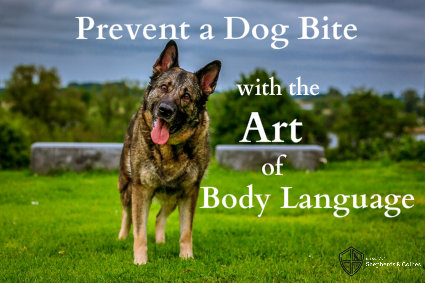Prevent a Dog Bite with the Art of Body Language
The Art of Body Language to Avoid a Dog Bite
According to the Center for Disease Control and Prevention, at least 4.5 million Americans are bitten by dogs each year with up to a million of those victims seeking medical attention. Children below 13 years are the most affected since they constitute 50 percent of the victims, followed by the seniors. The statutes in most U.S states recommend a dog be muzzled or euthanized after biting a human being. Of course, if humans could only understand a dog’s body language, allowing them to foresee an impending attack - and avoid it - most dogs seized by the animal control department would be free today. art of body language
It’s not a coincidence that most children are bitten by a familiar dog, usually a pet. Contrary to the dog and child’s familiarity with one another, the dog bites not because he likes attacking children, but because the child doesn’t understand the dog’s body language. Adults are also sometimes caught up in the feud and can’t help but wonder why the dog bites yet he’s friendly. However, it is quite possible to avoid a dog bite - for both children and adults - by reading the dog’s body language. It’s also important for you and your child to know how to react in case of an attack.
Herding breed dogs have a slightly different body language, expressed through their tail wags - read more in 8 Doggy Tail Wags.
Dogs usually bite whenever they feel threatened, scared, startled, or are protecting something. Don’t be naïve, even the friendliest dog can bite if pushed to the limit. Hence it is vital to always read their body language, depending on the situation, to determine if it is likely to trigger an attack.
Why Do Dogs Attack? How Do I Read A Dog's Body Language?
- Fear and Anxiety
A very intense, scared dog will tuck its tail, bark, tremble and run around trying to hide. The most common mistake people make is thinking that a dog behaving in such a way will not bite since he/she is scared of you, but it’s quite the opposite - fear and anxiety are the major reasons why dogs bite. A scared German Shepherd Dog will pace around aimlessly when afraid, but once you step into it’s territory and try to corner it, the dog will likely snap at you. Apart from the obvious telltale signs, there are other subtle signs to recognize fear and anxiety in your dog.
For instance, if you find your dog licking lips even though there is no food in close proximity, or panting when he/she is not thirsty or hot, then your dog is afraid of something or someone. The ears may also be bent backwards or sideways and the brows furrowed. On the other hand, moving in slow motion and yawning when not tired is a sign of anxiety. Watch out, too, for hypervigilant dogs that look in many directions, the way you would if you found yourself at a dangerous street at night.
- Threatened or Protecting Territory
Herding dogs have a reputation for holding onto their territory and the last thing you want to do is invade their personal space when they give you a clear sign to keep off. Growling is perhaps the most obvious sign of a dog that feels threatened, but most people don’t know, is that a wagging tail could also be a warning language. A stiffened body and a raised tail could be another indicator the dog is preparing to bite. If you are still not sure about the aforementioned warning, then nothing could be beyond doubt than if the dog proceeds to show you a half-moon eye and with an erect fur. At this point, you definitely shouldn’t expect your dog to start talking if you haven’t yet figured out his next course of action, based on his previous other signs.
What Do I Do If A Dog Attacks?
Unfortunately, knowing the signs of an impending canine bite is not always enough to prevent a dog bite, so you also need to know how to react if a dog attacks unexpectedly.
- Don’t Run or Scream
Unlike most humans in combat, dogs do not intensify their aggressive tendencies on a non-moving target. Just as dogs tend to nibble more at moving toys than constant objects, if you stand up straight against an attacking canine, the dog will likely halt the pursuit.
Although screaming is a natural response to danger, it is not the best course of action when attacked by a dog because it will make the dog more hostile. Sadly, the most likely reason why children are the highest casualty among dog bites is because they tend to move a lot when a dog nips - their natural instincts would tell them to fight and run, not to lie still.
- Mind Your Body Position
- If the body language of a dog suggests he/she is ready to bite, slowly move your body sideways or perpendicular to the dog.
- Keep in mind that anxious or fearful dogs are likely to bite when you suddenly turn their back on them.
- In case the dog knocks you to the ground, curl your body like a ball with your knees close to your stomach and fingers intertwined behind your head, protecting your ears and neck.
- Under normal circumstances, the dog will just sniff you and lose interest, but if the dog proceeds to bite, feed the dog with anything you can put between yourself and the dog.
- Do not give a strange dog direct eye contact or else the dog will perceive that as a challenge.
Do not pet a strange dog just because he/she looks cute and friendly. Imagine if every stranger you met on the road decided to hug or kiss you abruptly, how would you react? Disturbing a dog that is eating or sleeping, and getting in-between a mother and her puppies will also get you into conflict with even the friendliest dog.
More information: Center for Disease Control: Preventing Dog Bites
Article By:
Martin Mooray







